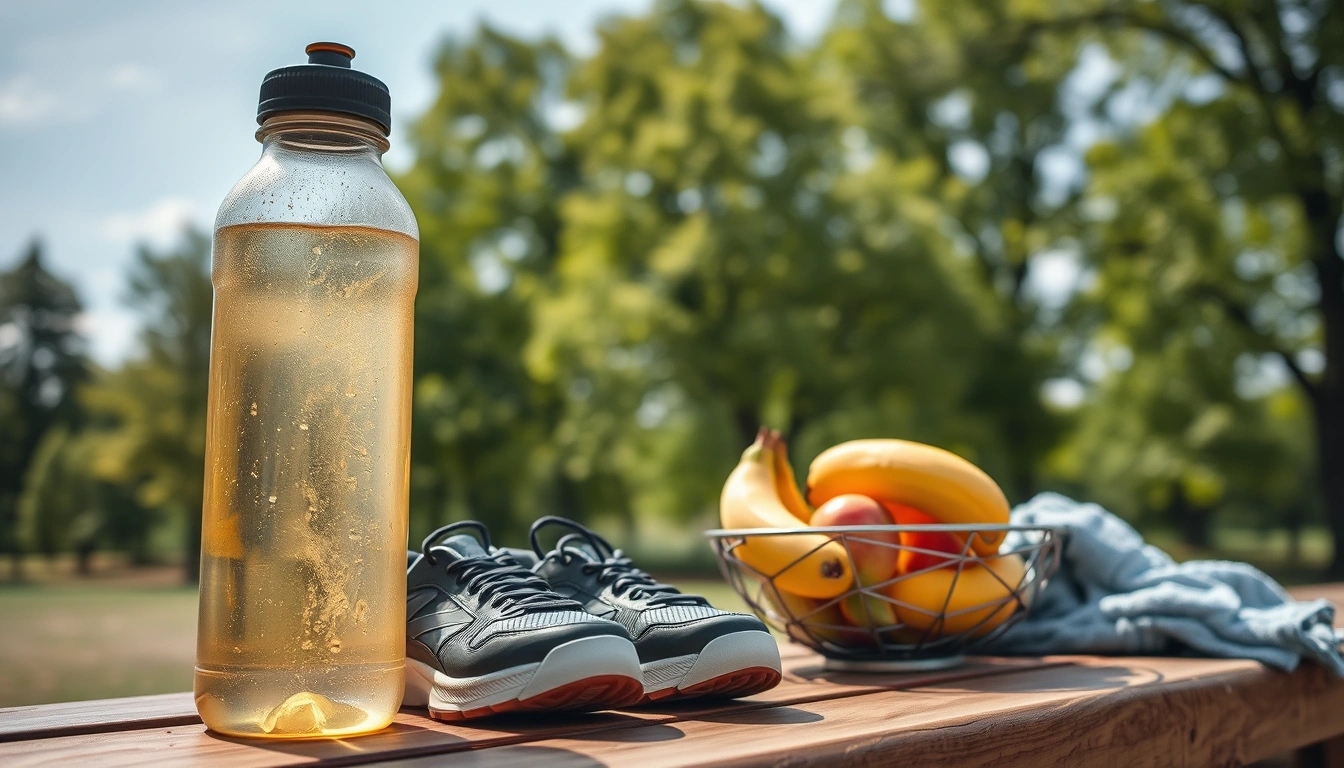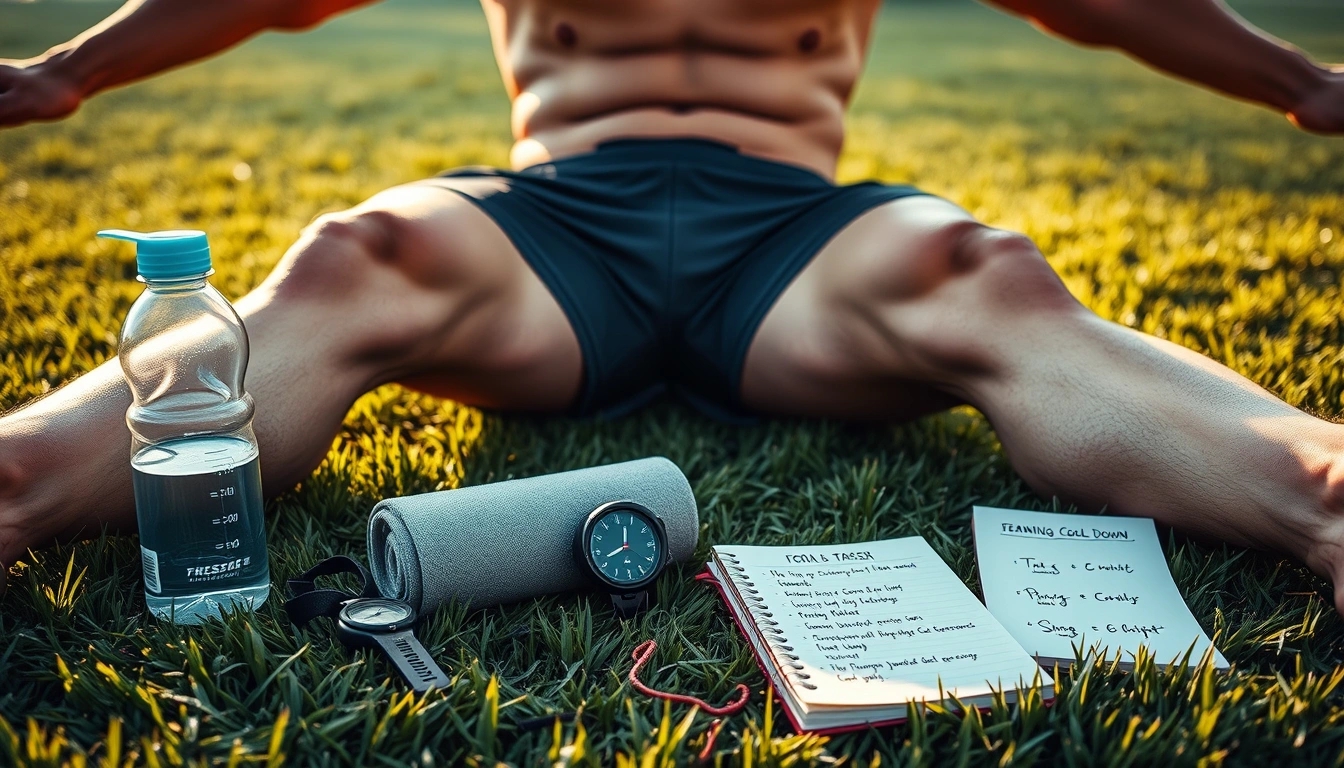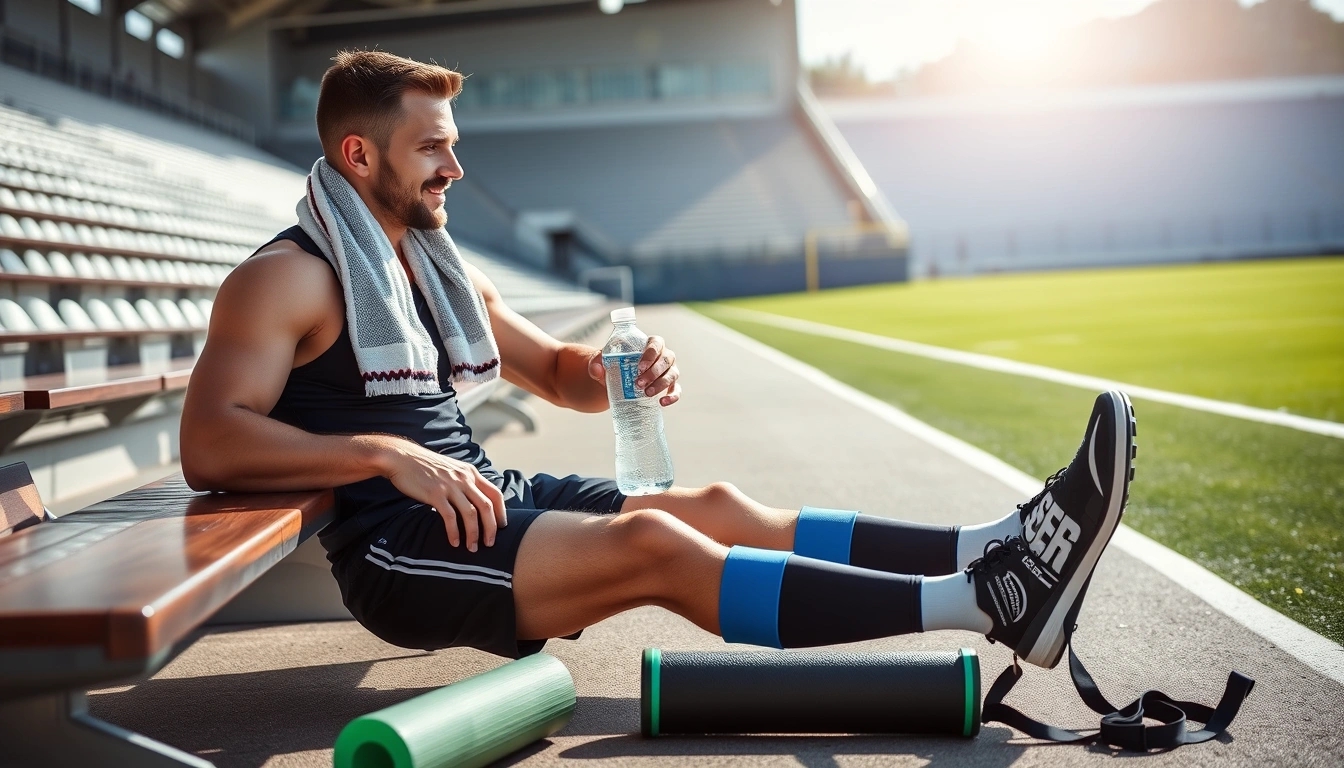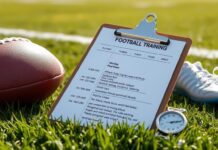Alright, so you just crushed it on the field, gave it your all, and now you’re thinking, “Can I just flop on the couch and binge some shows?” Hold up! Cooling down after a match isn’t just some optional fluff—it’s actually crucial if you want to bounce back quicker and hit the next game feeling like a champ, not like a limp noodle. Let’s unravel why this often-skipped ritual deserves your attention and how it can keep you fresh without turning into a couch potato.
First off, your body’s been through a rollercoaster of stress during the match—heart pumping, muscles screaming, lactic acid piling up like an annoying guest who won’t leave. Cooling down is like the gentle escort that helps your body exit the chaos calmly. Without it, your muscles stay tight, your heart rate drops too fast, and you’re left with soreness that could last days. Not fun.
| Why Cooling Down Matters | What Happens If You Skip It |
|---|---|
| Gradual heart rate reduction | Sudden drop causing dizziness or fatigue |
| Flushes out lactic acid and toxins | Lactic acid buildup leads to cramps and stiffness |
| Reduces muscle soreness | Increased muscle tightness and delayed recovery |
| Prevents blood pooling in legs | Swelling and discomfort |
Now, let’s talk techniques. It’s not rocket science—just simple stuff like light jogging, walking, or some slow cycling to keep blood flowing without pushing those muscles again. Think of it as a cool breeze after a storm, easing tension and nudging your body towards recovery. Stretching also plays a starring role here, but don’t go all contortionist on yourself. Focus on gentle stretches that lengthen your muscles and keep stiffness at bay.
- Active Recovery: Low-intensity moves that maintain circulation without overloading your muscles.
- Stretching: Target major muscle groups used during the match to prevent tightness.
- Breathing Exercises: Helps calm your nervous system and restore oxygen balance.
Oh, and hydration? Don’t even think about skipping it. Your body’s been sweating buckets, losing electrolytes and fluids. Chugging water is obvious, but sometimes you need a bit more—sports drinks or a smoothie packed with carbs and protein can do wonders. Timing matters too; gulping down fluids immediately and within an hour post-match really helps your system reboot.
| Post-Match Hydration & Nutrition | Why It Helps |
|---|---|
| Water | Replenishes fluids lost through sweat |
| Electrolyte drinks | Restores sodium, potassium, magnesium balance |
| Protein-rich foods | Repairs muscle fibers and promotes recovery |
| Carbohydrates | Refills glycogen stores for energy |
Before you dash off, beware of some common blunders. Rushing through your cool down or ignoring it altogether might seem like saving time, but it’s a trap. You’re basically telling your body, “Hey, I don’t care if you’re wrecked.” And guess what? That’s a fast track to injuries or feeling wiped out for days. Also, gadgets like foam rollers or massage guns can be handy but don’t expect miracles overnight.
In the end, crafting a cool-down routine that fits your sport, fitness level, and schedule is the secret sauce. Make it part of your post-match ritual—not a chore. Because trust me, your future self will thank you when you’re ready to hit the next game running, not crawling.
Quick Cool Down Checklist:
- Light jogging or walking for 5-10 minutes- Gentle stretching of key muscle groups- Deep breathing exercises- Hydrate with water or electrolyte drinks- Refuel with protein and carbs within 30-60 minutes- Use foam roller or massage tools if available
So, next time you finish a match, don’t just drop. Cool down like a pro and speed up that recovery game. Your muscles—and your next performance—will thank you big time.
Why Cooling Down Matters
You might think that once the final whistle blows, it’s time to toss your gear aside and collapse on the nearest couch. But hold up—cooling down after a match isn’t just some optional luxury; it’s actually a critical step your body desperately needs. Imagine your body as a high-performance machine that’s been running full throttle. Suddenly slamming on the brakes without easing off the gas? Not the smartest move. That’s exactly what skipping a cool down does—it leaves your muscles and cardiovascular system hanging, like a car engine left to idle recklessly.
Here’s the deal: during intense play, your heart rate spikes, muscles contract hard, and your blood vessels dilate to get oxygen flowing. When the game ends abruptly, your heart rate plummets too fast, and blood can pool in your legs instead of circulating back to your heart. This can cause dizziness, cramps, or worse, delayed recovery. Cooling down acts as a gentle tap on the brakes, gradually slowing your heart rate and helping your body transition from high alert back to chill mode. It’s like giving your system a chance to catch its breath and reset.
| What Happens If You Skip Cooling Down? | Why Cooling Down Helps |
|---|---|
| Blood pooling in muscles causing soreness and cramps | Encourages steady blood flow, flushing out waste products like lactic acid |
| Sudden drop in heart rate causing dizziness or fainting | Gradual heart rate reduction prevents lightheadedness |
| Muscle stiffness and delayed recovery | Stretching during cool down maintains muscle flexibility |
| Increased risk of injury next game | Proper recovery prepares muscles for next performance |
Now, don’t get me wrong—cooling down isn’t about turning your post-match routine into a snooze fest. It’s more like giving your body a respectful nod for all the hard work it just pulled off. Think of it as the difference between slamming a door shut versus gently closing it. The latter just feels better, right? Plus, it can actually shave days off your recovery time, letting you hit the next game fresher than a daisy.
- Improves circulation: Helps transport nutrients and oxygen to tired muscles.
- Reduces muscle soreness: Flushing out metabolic waste like lactic acid.
- Prevents stiffness: Stretching keeps muscles flexible and joints happy.
- Calms the nervous system: Lowers stress hormones and promotes relaxation.
So next time you’re tempted to bolt straight for the locker room or dive into a hot shower, remember: your body’s not just craving a break—it’s begging for a cooldown ritual. Skipping it? That’s like leaving money on the table, or worse, setting yourself up for a grumpy, stiff, and slower comeback. Trust me, your muscles will thank you later, even if your brain is itching to binge-watch the latest series instead.
Quick recap: - Cool down gradual slow down, not a sudden stop - Keeps blood flowing, flushes toxins - Prevents dizziness and cramps - Helps muscles relax and lengthen - Speeds up recovery for next game
In the grand scheme of things, cooling down might seem like a minor detail, but it’s actually a game-changer. So don’t just wing it—give your body the respect it deserves and cool down like a pro. Your future self (and those muscles) will be grateful.
Top Cooling Down Techniques
Alright, so you’ve just wrapped up a grueling match — your legs feel like jelly, your lungs are on fire, and all you want to do is flop on the couch and binge-watch your favorite show. But hold up! Before you dive headfirst into that well-deserved laziness, let’s talk about why cooling down is more than just a fancy term coaches throw around. It’s the secret sauce to bouncing back faster, avoiding those nasty cramps, and keeping your muscles from staging a rebellion the next day.
First off, cooling down isn’t about stopping cold turkey. Nope, it’s a gentle slide from full throttle to chill mode. Think of it like easing your car into park instead of slamming the brakes. One of the most popular methods? Light jogging or brisk walking. This low-intensity movement keeps your blood pumping, which helps flush out lactic acid — that pesky stuff that makes your muscles scream “Why me?” after intense effort. Plus, it helps prevent blood pooling in your legs, which can leave you dizzy or with that weird heavy-legged feeling.
| Technique | Purpose | Duration |
|---|---|---|
| Light Jogging/Walking | Flush lactic acid, maintain blood flow | 5-10 minutes |
| Static Stretching | Lengthen muscles, reduce stiffness | 10-15 minutes |
| Foam Rolling | Release muscle knots, improve circulation | 5-10 minutes |
Now, let’s talk about stretching. This ain’t just about showing off your flexibility or trying to touch your toes without grimacing. Post-match stretching helps realign your muscle fibers, which get all bunched up during high-intensity play. It’s like giving your muscles a gentle “Hey, relax!” message so they don’t turn into tight, grumpy little beasts the next day. Focus on major muscle groups — hamstrings, quads, calves, and your back — but don’t overdo it. Stretching should feel good, not like you’re trying to rip yourself apart.
- Dynamic stretches right after the game can help maintain mobility.
- Static stretches are better once your heart rate is down, to really calm the muscles.
And hey, if you’re feeling fancy or just want to treat your body like the temple it is, foam rolling is a game-changer. It’s basically self-massage on steroids. Rolling out tight spots breaks down adhesions and knots, boosting blood flow and speeding recovery. Just don’t go overboard and torture yourself — a few minutes per muscle group is plenty.
Pro Tips for Cooling Down:- Keep it light; no sprints or heavy lifting right after the game.- Hydrate during your cool down to help flush toxins.- Listen to your body — if something hurts, don’t push it.- Mix and match techniques to keep things interesting.
In short, cooling down is like hitting the reset button on your body. It might seem like a drag when you’re wiped out, but trust me, those extra 15-20 minutes will save your legs (and your sanity) later. So next time you finish a match, don’t just bail — jog, stretch, roll, and hydrate your way to a quicker recovery. Your future self will thank you.
Active Recovery: Moving but Not Too Much
Let’s get one thing straight: active recovery isn’t just about “doing something” after a match. It’s a delicate dance between motion and rest, where you keep your body ticking without pushing it over the edge. Think of it like trying to pat your dog gently while it’s still hyper from a walk — you want to soothe, not excite. This phase is often misunderstood or overlooked, but it’s a game-changer for anyone serious about bouncing back quicker.
At its core, active recovery means engaging in low-intensity movements that keep your blood pumping, flushing out metabolic waste like lactic acid, and delivering oxygen to tired muscles. But here’s the kicker — you don’t want to stress those muscles anymore than necessary. So, no sprints, no heavy lifting, and definitely no “let’s see how fast I can run now” nonsense. It’s more like a slow bike ride, light swimming, or a gentle walk — activities that feel more like a warm hug than a boot camp.
- Why bother? Because after a high-intensity match, your muscles are basically screaming “help!” with micro-tears and inflammation. Active recovery helps reduce soreness and stiffness, making sure you’re not hobbling around like an old-timer the day after.
- Timing matters. Jumping into active recovery right after the match is ideal. Waiting too long can let waste products settle in, turning your muscles into a toxic swamp.
- Keep it light. If you’re gasping for air or feeling muscle burn, you’re doing it wrong.
| Activity | Intensity Level | Benefits |
|---|---|---|
| Walking | Very Low | Improves circulation, reduces muscle stiffness |
| Light Cycling | Low | Enhances blood flow without muscle fatigue |
| Swimming (easy pace) | Low | Full-body movement, gentle on joints |
| Yoga or Stretching | Low | Improves flexibility, reduces tension |
Now, here’s where things get a little tricky. Some folks confuse active recovery with just “moving around.” Nope. You can’t just stroll around the house or do chores and call it a day. The key is purposeful, controlled movement that targets the muscles you used but doesn’t add new strain. It’s like telling your muscles, “Hey, relax, I got you,” rather than “One more round!”
Also, don’t fall into the trap of skipping active recovery because you’re “too tired” or “just want to crash.” That’s like ignoring a warning light on your car’s dashboard — you might get away with it once or twice, but eventually, you’ll pay the price. Even a 10-15 minute light session can make a world of difference.
Tips for Effective Active Recovery:- Keep your heart rate at about 50-60% of your max- Focus on smooth, rhythmic movements- Avoid any exercises that cause pain or discomfort- Hydrate well before, during, and after your session- Combine with gentle stretching to maximize benefits
To wrap it up, active recovery is that unsung hero in your post-match routine. It’s not flashy, it’s not sexy, but it’s the secret sauce that keeps you fresh, less sore, and ready to hit the next game with gusto. So next time you’re tempted to flop on the couch right after the final whistle, remember: moving just a little might be exactly what your body’s begging for.
Stretching: More Than Just Flexibility
Stretching after a match isn’t some boring ritual where you just bend over to touch your toes and call it a day. Nope, it’s way more than that. Think of it as giving your muscles a much-needed breather and a gentle nudge to relax after all that intense action. When you’ve been sprinting, tackling, or just flat-out hustling on the field, your muscles tighten up like a coiled spring. If you ignore stretching, that tightness doesn’t just vanish—it sticks around and can make you feel like you’ve been hit by a truck days later. Nobody wants that, right?
Now, the magic behind stretching is all about lengthening those muscle fibers that have been working overtime. When muscles contract during play, they get shorter and tighter. Stretching helps them return to their normal length, reducing stiffness and soreness. Plus, it improves blood flow, which is like sending a repair crew to your muscles to flush out all the nasty lactic acid and bring in oxygen and nutrients. This process is crucial because lactic acid buildup is one of the main culprits behind that dreaded post-match ache.
- Dynamic stretching right after the match can be a game-changer. It’s all about controlled movements—like leg swings or arm circles—that keep your body moving but at a relaxed pace.
- Static stretching, where you hold a stretch for 20-30 seconds, is best saved for a few minutes later or during your cool-down session.
| Type | Description | Benefits |
|---|---|---|
| Dynamic Stretching | Active movements that mimic the sport activity | Increases blood flow, warms up muscles, reduces injury risk |
| Static Stretching | Holding a stretch position for 20-30 seconds | Improves flexibility, reduces muscle tension |
| PNF Stretching | Contract-relax technique with partner assistance | Enhances flexibility and range of motion |
But hey, be careful not to overdo it. Stretching doesn’t mean pushing your body to the point of pain. That’s a rookie mistake and can backfire big time. Instead, aim for a comfortable stretch where you feel that gentle pull—nothing more. Remember, the goal is to help your muscles relax, not to punish them.
Here’s a quick, no-nonsense list of stretches that cover all the bases post-match:
- Hamstring stretch: Sit down, reach for your toes, and hold.
- Quad stretch: Stand on one leg, pull the other foot towards your butt.
- Calf stretch: Lean against a wall with one foot back, heel down.
- Shoulder stretch: Pull one arm across your chest and hold.
- Hip flexor stretch: Lunge forward, keeping your back leg straight.
Lastly, don’t underestimate the mental perks. Stretching gives you a moment to catch your breath, reflect on the game, and mentally unwind. It’s like telling your body, “Hey, good job today, now let’s chill.” So next time you’re tempted to skip it, remember: stretching is your secret weapon to dodge stiffness, speed up recovery, and get back on that field feeling like a champ.
In short: Stretching post-match not just flexing your flexibility but saving your muscles from turning into a stiff mess. Give it the respect it deserves, and your body will thank you big time.

Hydration and Nutrition Post-Match
Alright, let’s get real for a second. You just finished a grueling match, sweat pouring like Niagara Falls, lungs burning, legs screaming—what’s the first thing you do? Collapse on the bench, gulp down some random drink, and maybe grab a snack if you’re lucky? Well, if that’s your routine, you’re missing out big time. Rehydrating and refueling aren’t just some fancy words coaches throw around to sound smart—they’re the lifeline for your body after all that chaos on the field.
Think about it: during a match, you’re sweating buckets, losing not just water but essential electrolytes like sodium, potassium, and magnesium. These little guys are crucial for muscle function and nerve signaling. Skipping on replenishing them? That’s like trying to drive a car on empty. You might get a few miles, but eventually, you’re gonna stall.
- Water is your go-to, no doubt. But plain water sometimes just won’t cut it, especially if you’ve been sweating heavily for over an hour.
- Electrolyte drinks or sports beverages can help restore that balance, but watch out for the sugar overload—too much and you’re basically undoing all the good you did.
- Natural options like coconut water or homemade electrolyte drinks are surprisingly effective and less processed.
| Fluid Type | Best For | Watch Out For |
|---|---|---|
| Water | Short matches, light sweat | Doesn’t replace electrolytes |
| Sports Drinks | Long matches, heavy sweat | High sugar content |
| Coconut Water | Natural electrolyte boost | May lack enough sodium |
Now, on to food—because hydration alone won’t magically fix your battered muscles or energy stores. Post-match nutrition is like telling your body, “Hey, time to repair and gear up for the next round.” You want a good balance of protein to rebuild muscle fibers, carbs to restock glycogen, and a sprinkle of antioxidants to fight off inflammation.
- Protein: Think chicken breast, eggs, Greek yogurt, or plant-based options like lentils. Your muscles will thank you.
- Carbs: Whole grains, sweet potatoes, or fruits—these replenish your energy tanks faster than you can say “extra time.”
- Antioxidants: Berries, nuts, and leafy greens help calm down the oxidative stress caused by intense physical activity.
Sample Post-Match Meal:- Grilled chicken breast- Quinoa salad with mixed veggies- A handful of blueberries- A glass of coconut water
Timing matters too. Chowing down immediately after the match (within 30-60 minutes) maximizes nutrient absorption and jumpstarts recovery. Waiting too long? Well, you might as well be telling your muscles, “Nope, no help today.”
So, yeah, hydration and nutrition post-match aren’t just about feeling good—they’re about being smart. Ignore this, and you’re basically playing a game of Russian roulette with your recovery. Nail it, and you’ll bounce back faster, feel fresher, and maybe even surprise yourself on the pitch next time.
Pro tip: Keep a small recovery kit handy—water bottle, electrolyte mix, and some easy-to-carry snacks. Trust me, your future self will thank you when you’re not dragging through the next training session like a zombie.
In the end, it’s all about respecting the sweat, the effort, and your body’s needs. Don’t just cool down—fuel up and hydrate like a champ.
What to Drink and When
Alright, so you just wrapped up a grueling match, sweat dripping like you just ran through a monsoon, and now it’s time to think about what’s going back into that thirsty body of yours. Hydration isn’t just about gulping down a bottle of water and calling it a day. Nope, timing and the type of fluid you pick can seriously make or break your recovery game. Let’s get into the nitty-gritty of what you should be sipping on and when.
First off, water is your trusty sidekick. It’s simple, effective, and usually all you need if your match wasn’t a sweat-fest. But if you’ve been sweating buckets, losing not just water but also crucial electrolytes like sodium, potassium, and magnesium, plain water won’t cut it. Drinking only water in that case can dilute your blood’s electrolyte concentration, leading to cramps or worse, hyponatremia (fancy word for low sodium). So, what’s the fix? Enter electrolyte drinks.
| Drink Type | Best Used | Pros | Cons |
|---|---|---|---|
| Water | Short matches, minimal sweat loss | Hydrates quickly, zero calories | Doesn’t replenish electrolytes |
| Electrolyte Drinks | Long matches, heavy sweating | Replenishes salts and minerals lost | Some have added sugars, can be pricey |
| Smoothies (Fruit + Protein) | Post-match recovery, refueling | Provides carbs, protein, antioxidants | Not always convenient on the field |
| Coconut Water | Moderate sweat loss, natural electrolyte boost | Natural, low calorie, potassium rich | Can be high in sugar, limited sodium |
Now, when to drink these magical potions? The golden rule is to start hydrating during the match if possible. Taking small sips every 15-20 minutes helps keep your energy and focus sharp. Post-match, don’t just chug a whole bottle at once thinking you’ll fix everything in one go. Your body can only absorb so much at a time. Instead, sip steadily over the next hour or two.
- Immediately after: Grab water or an electrolyte drink to kickstart rehydration.
- 30-60 minutes later: Consider a smoothie or a balanced snack with carbs and protein to jumpstart muscle repair.
- Throughout the day: Continue sipping water to maintain hydration balance.
Quick heads up: don’t fall for the hype around energy drinks loaded with caffeine and sugar right after a match. They might give you a quick buzz, but they can also dehydrate you further and mess with your recovery.
Tips for smart hydration:- Avoid gulping large amounts at once.- Match your fluid intake to sweat loss; if you’re pouring it out, you gotta pour it back in.- Experiment during training to find what works best for you.
So yeah, next time you’re thinking, “Eh, I’ll just drink water,” remember that a bit of strategy can turn your post-match drink into a secret weapon. Whether it’s water, electrolytes, or a nutrient-packed smoothie, timing and choice matter more than you might think. Your body will thank you—and your next game might just show it.
Foods That Speed Recovery
Alright, so you just finished a grueling match, sweat dripping, muscles screaming, and your brain’s probably thinking about crashing on the couch with zero guilt. But hold up! What you chow down right after the game can seriously flip the script on how fast you bounce back. We’re talking about turning your body into a full-on repair factory, not just a tired wreck. So, what’s the magic combo? Protein, carbs, antioxidants — the holy trinity of recovery eats.
Protein is the MVP here. Your muscles took a beating, right? They’re full of tiny tears that need fixing ASAP. Eating protein post-match supplies the amino acids that act like little construction workers, patching up those muscle fibers. Think lean meats, eggs, dairy, or plant-based options like lentils and chickpeas. Don’t just gulp down a protein shake and call it a day; whole foods pack more punch with vitamins and minerals that shakes often miss.
| Protein Sources | Why They Rock |
|---|---|
| Chicken Breast | Lean, high in essential amino acids |
| Greek Yogurt | Protein + probiotics for gut health |
| Tofu | Plant-based, versatile, rich in protein |
| Eggs | Complete protein with healthy fats |
Now, onto carbs. After all that running around, your glycogen stores (your muscles’ fuel tanks) are running on empty. Replenishing carbs is like refilling your gas tank — no fuel, no zoom. But don’t just grab candy bars or sugary drinks (tempting, I know). Opt for whole grains, fruits, and veggies. They release energy steadily, preventing that dreaded sugar crash and keeping your engine humming for the next match or training session.
- Sweet potatoes – loaded with complex carbs and vitamins
- Berries – antioxidants and natural sugars
- Oats – fiber-rich and slow-burning energy
- Bananas – potassium-rich to help muscle cramps
Speaking of antioxidants, these little warriors are crucial because intense exercise generates free radicals that can damage cells. Antioxidants neutralize these nasties, reducing inflammation and speeding healing. Blueberries, cherries, spinach, and nuts are your best pals here. Toss them into smoothies or salads — your body will thank you.
Here’s a quick snapshot of a post-match recovery snack that hits all the right notes:
- Grilled chicken wrap with spinach and avocado- Side of roasted sweet potato wedges- A handful of mixed berries- A glass of water or electrolyte drink
And hey, don’t forget hydration! Food alone won’t cut it if you’re dehydrated. Water’s the obvious go-to, but adding electrolytes (think sodium, potassium) helps replace what you lost sweating buckets. Sports drinks can be handy, but watch the sugar content — sometimes it’s more candy than hydration.
So next time you’re tempted to wolf down whatever’s easiest post-game, remember: what you eat can either fast-track your recovery or slow it to a crawl. Your body’s basically begging for the right fuel to get back in the game. Treat it well, and it’ll treat you better.
Common Mistakes to Avoid
Alright, let’s get real for a moment. When it comes to cooling down after a match, a lot of players just blow it off like it’s some optional extra—kind of like the fries you skip because you’re “watching your diet.” But here’s the kicker: skipping or rushing your cool down isn’t just a harmless shortcut, it’s like leaving your car engine running at full throttle without letting it settle. It might seem like a time-saver, but in the long run, it can seriously mess with your recovery and up your chances of getting sidelined with an injury.
One of the biggest slip-ups? Jumping straight into a hot shower or plopping down on the couch immediately after the final whistle. Your muscles are screaming for a gentle wind-down, not a sudden stop. When you abruptly halt activity, blood pools in your legs, which can cause dizziness or cramps. Plus, all that lactic acid that built up during the game? It needs to be flushed out gradually, not left to hang around and cause stiffness the next day.
| Mistake | Why It’s Bad | Better Alternative |
|---|---|---|
| Skipping cool down entirely | Delays muscle recovery, increases injury risk | 5-10 minutes of light jogging or walking |
| Rushing through stretches | Muscles remain tight, flexibility suffers | Hold stretches for at least 20-30 seconds |
| Ignoring hydration | Dehydration slows recovery, cramps more likely | Drink water or electrolyte drinks post-match |
| Using cold water immersion without prep | Can cause shock to muscles if not done properly | Warm down first, then short cold baths |
And oh boy, don’t even get me started on the “cool down” that’s just a quick walk to the locker room while scrolling through your phone. That’s not cooling down, that’s just moving your legs without purpose. Active recovery means keeping the blood pumping gently, not zoning out like a zombie. It’s a fine line, but trust me, your muscles will thank you.
- Active recovery: light jogging, walking, or cycling at a slow pace
- Stretching: focus on major muscle groups used in the match
- Hydration: replenish fluids lost through sweat
Another rookie error is thinking that stretching is just about “looking cool” or hitting the splits. Nope. Stretching after a game is about loosening those tight muscles so you don’t wake up feeling like a rusty robot the next day. Skimp on this, and you’re basically inviting soreness and stiffness to crash your recovery party.
Lastly, some players swear by fancy gadgets or extreme recovery hacks without understanding what’s actually helpful. Foam rollers and massage guns can be great, but they won’t replace the basics. If you’re skipping the simple stuff and hoping tech will bail you out, you’re setting yourself up for disappointment.
So, the takeaway? Don’t be lazy. Your cool down is just as important as your warm-up or your actual game. Treat it like the secret sauce that keeps you fresh, fast, and injury-free. And if you’re guilty of any of these mistakes, no shame—just start fixing them today. Your body will thank you tomorrow (and the day after that, too).
Tools and Gadgets to Enhance Cooling Down
Alright, let’s talk about the shiny toys and gizmos flooding the market promising to turn your post-match cooldown into a spa day. From foam rollers that look like giant rolling pins to those buzzing massage guns that make you feel like a tech-savvy masseuse, there’s no shortage of options. But before you throw your hard-earned cash at every gadget, a little heads up: not all that glitters is gold.
First off, foam rollers are the granddaddies of recovery tools. They’re simple, effective, and pretty much foolproof. Rolling out tight muscles helps increase blood flow and break down knots — basically giving your muscles a gentle “wake up” call after the grind. Plus, they don’t require batteries or fancy apps, and you can find them at most sporting stores for a reasonable price. Just remember, it’s not a magic wand. If you’re gritting your teeth every time you roll, you might be going too hard or on the wrong spots.
| Gadget | Pros | Cons | Best For |
|---|---|---|---|
| Foam Roller | Affordable, simple, effective | Can be painful if used incorrectly | Muscle tightness and trigger points |
| Massage Gun | Deep tissue relief, customizable intensity | Expensive, noisy, may cause bruising | Targeted muscle soreness |
| Compression Boots | Improves circulation, reduces swelling | Costly, bulky, requires power source | Leg recovery post-match |
Now, massage guns have skyrocketed in popularity, and yeah, they feel pretty darn good. Those rapid pulses penetrate deep into muscle tissue, which can help with stiffness and soreness. But here’s the kicker: they’re not for everyone. If you’re the type who bruises easily or has certain medical conditions, you might want to steer clear. Also, don’t get fooled by brands claiming their device can “erase fatigue instantly” — that’s just marketing fluff. Use it wisely, and it’s a nice addition to your cooldown arsenal, not a replacement for good old-fashioned stretching.
- Pro tip: Start with the lowest setting and keep the gun moving — don’t hold it in one spot too long.
- Warning: Avoid bony areas and inflamed spots.
Compression boots? Fancy, right? They’re like giving your legs a hug that boosts circulation and flushes out metabolic waste. Athletes swear by them, especially after grueling matches or long travel days. But the price tag and the need for an outlet make them a luxury rather than a necessity. If you’re serious about recovery and have the budget, they can be a game-changer. Otherwise, sticking to simpler methods may be just as effective.
In the end, the best tool is the one you actually use. No gadget will replace the basics: light movement, stretching, hydration, and rest. So, if you want to splash out on some tech, go for it — but keep your expectations in check. Remember, recovery is a marathon, not a sprint, and sometimes, the simplest tools do the trick just fine.
Quick Checklist for Gadget Use:
- Understand your body’s needs before buying- Don’t rely solely on gadgets; mix with active recovery- Learn proper techniques to avoid injury- Be wary of over-hyped claims- Listen to your body’s feedback
So, next time you see that flashy new massage gun or compression gear, ask yourself: is this a smart investment or just another gimmick? Your muscles will thank you either way — as long as you don’t skip the cooldown altogether.

Creating Your Personalized Cool-Down Routine
Alright, let’s get real about cooling down. It’s not some one-size-fits-all magic trick you pull out after every sweaty session. Nope, your cool-down should be as unique as your playlist or that weird pre-game ritual you swear by. The trick? Tailoring it to your sport, fitness level, and, oh yeah, your busy schedule. Because if it feels like a drag, you won’t stick with it — and that’s just asking for tight muscles and slower recovery.
So, first off, think about your sport. Are you a sprinter who explodes for 10 seconds, or a soccer player running up and down for 90 minutes? Your cool-down needs to reflect that. Sprinters might want to focus on gentle jogging and dynamic stretches to gradually bring heart rate down, while endurance athletes benefit from longer, slower movement and static stretching to loosen those tired limbs.
| Sport Type | Recommended Cool-Down | Why It Works |
|---|---|---|
| Sprinting/Short Burst Sports | Light jogging + dynamic stretches | Prevents blood pooling, maintains muscle elasticity |
| Endurance Sports (Soccer, Basketball) | Slow walking + static stretching | Gradual heart rate reduction, muscle lengthening |
| Strength Training | Foam rolling + mobility drills | Releases muscle knots, improves flexibility |
Next up, your fitness level. Rookie or pro, we all gotta start somewhere. If you’re just getting into the game, keep it simple. A few minutes of walking and some easy stretches will do wonders without leaving you wiped out. For the seasoned vets, you might want a more structured cool-down with targeted mobility work or even some light yoga poses — because hey, you’re not just playing, you’re maintaining a machine here.
And, oh boy, don’t forget your schedule. Life’s busy, I get it. Sometimes you’ve got 30 minutes, sometimes 5. Don’t let that stop you. Even a quick 3-minute cool-down beats zero. Here’s a quick cheat sheet for busy folks:
- Under 5 minutes: Walk it off and do a few deep breaths.
- 5-10 minutes: Add in some gentle stretching focusing on major muscle groups.
- 10+ minutes: Full routine including foam rolling, stretching, and light movement.
Remember, the key is to listen to your body. If something feels tight or sore, spend a bit more time there. If you’re feeling good, keep it light and breezy. The last thing you want is to turn your cool-down into a second workout — that’s just cruel.
Quick Tips for Personalizing Your Cool-Down:- Match the intensity to your workout.- Focus on muscle groups used the most.- Adjust duration based on time available.- Mix active recovery with stretching.- Hydrate and refuel immediately after.
So, next time you wrap up your match or training, don’t just flop on the couch. Take a few minutes to tailor your cool-down — it’s the secret sauce to feeling fresh, avoiding injuries, and being ready to crush it next time. Trust me, your future self will thank you.
Frequently Asked Questions
- Why is cooling down after a match so important?
Cooling down helps your body transition from intense activity to a resting state smoothly. It reduces muscle stiffness, flushes out lactic acid, and prevents dizziness or fainting by gradually lowering your heart rate. Think of it as giving your body a gentle landing after a high-speed flight—skip it, and you risk a rough touchdown that can slow your recovery.
- What are the best cooling down techniques to try?
Simple, low-intensity movements like light jogging or walking followed by stretching work wonders. These activities keep blood flowing to your muscles, helping clear out waste products and easing tension. It’s like gently untangling knots in a rope rather than yanking it apart—your muscles will thank you!
- How does active recovery differ from just resting?
Active recovery means moving just enough to keep your blood circulating without adding stress. Unlike complete rest, which can cause stiffness, active recovery acts like a gentle massage from the inside, speeding up healing and reducing soreness.
- What should I drink after a match to recover properly?
Hydration is key! Water is great, but after heavy sweating, replenishing electrolytes with sports drinks or natural options like coconut water can be a game changer. Timing matters too—start sipping fluids as soon as you cool down to maximize absorption.
- Which foods help speed up recovery post-match?
Protein helps rebuild muscles, carbs restore energy, and antioxidants fight inflammation. Think of your plate as a toolbox: lean meats, whole grains, fruits, and veggies are your essential tools to fix and fuel your body fast.
- Can skipping the cool down really increase injury risk?
Absolutely! Rushing off without cooling down is like slamming brakes on a moving car—it stresses your muscles and joints, making strains, cramps, or worse injuries more likely. Taking those extra minutes can save you days of pain.
- Are foam rollers and massage guns worth using after a match?
These tools can enhance muscle relaxation and blood flow, acting like a personal masseuse. However, they’re not magic wands—use them wisely and combine with traditional cool down methods for best results.
- How do I create a cool-down routine that fits my sport and schedule?
Start with 5-10 minutes of light movement, add targeted stretches focusing on muscles you used most, and finish with hydration and nutrition. Adjust intensity and duration based on your fitness level and time constraints—consistency beats complexity every time.












